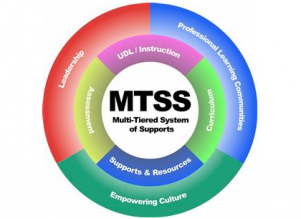5/7/2018
Understanding the MTSS Problem-Solving Process: What You Need to Know
The terms MTSS (Multi-Tier System of Supports) and RTI (Response to Intervention) are often used interchangeably among educators, but the truth is these two frameworks are NOT one in the same. MTSS is a set of evidence-based practices implemented across a system to meet the needs of all learners (Kansas Multi-Tier System of Supports [MTSS]: Academic Structuring Guide, 2011). The MTSS framework is broader than Response to Intervention or a problem-solving process alone. It establishes a paradigm of support service delivery focused on leadership, professional development, and empowering culture within the context of assessment, curriculum, and instruction.
Within this system, there are typically three tiers of supports where students receive instruction and interventions to help them on their path to achievement. Determining the appropriate interventions for each student is vital to the success of this system, and MTSS utilizes a data-driven decision-making process to aid in those determinations.
The MTSS problem-solving process consists of four important steps:
-
Define the problem or goal
-
Analyze the problem and relevant data
-
Implement an intervention plan
-
Evaluate the intervention for effectiveness
1. Define the problem
The first step in the decision-making process determines the goal and direction of the rest of the process. A team must identify what problem needs to be solved—such as lack of adequate academic progress or a non-academic situation such as poor attendance or behavior. Teams may look at the difference between the desired outcome in an area and the actual performance of a student in order to select the appropriate problem to highlight.
2. Analyze the data
MTSS is a system driven by data. After a problem has been defined, it is necessary to review the data to determine the cause. The cause could be a specific skill deficit or various gaps in a particular domain of learning, or, alternatively, it could be based on a non-academic factor. In the second step of the problem-solving process, team members gather relevant information and data and then analyze it to not only determine the problem, but also pinpoint what barriers may exist to successfully achieving the goal.
The ICEL/RIOT matrix is a useful tool for identifying the proper type of data needed for decision-making.
-
ICEL stands for four domains of learning to be assessed during the problem-solving process:
I - Instruction
C - Curriculum
E - Environment
L - Learner
-
RIOT includes four potential sources of data:
R - Review of records
I - Interviews of key stakeholders who are familiar with the student
O - Observation of student in a regular setting
T - Test student using various methods of measurement
The data collected provides a good overview of the student’s needs and is helpful in explaining the occurrence of a problem. It also serves as a foundation for designing an appropriate intervention plan in the next step of the process.
3. Implement an intervention plan
Having focused on the process of defining the problem and analyzing the data, the problem-solving team is then ready to design and implement an intervention plan that is appropriate for a student’s specific needs as shown by the data.
The Florida Department of Education identifies specific criteria for interventions in “A Teacher’s Guide to Problem Solving Within the MTSS Framework.” These specific criteria indicate that interventions should:
-
Consist of evidence-based programs, strategies, and techniques
-
Be delivered with integrity and fidelity
-
Allow for intensified instruction
-
Be implemented for a sufficient time and an evaluated frequently, and be integrated across the tiers
Using the problem-solving process for decision-making allows for interventions to be designed to address the unique needs and situation of each student, and provides for flexibility in both intensity and implementation of a plan. Frequent progress-monitoring during implementation is important for proper execution of the last step of the process—evaluating the intervention.
4. Evaluate the intervention
After spending time to create and implement an intervention, it is essential for teams to spend time evaluating. In this step, the decision-making team must determine if the intervention was considered successful and whether the student responded well to the intervention strategy.
If the data is showing adequate progress, the team can decide if continuing the intervention is necessary. If the data is not showing as much progress as expected, team members can make changes to the intervention plan. If evaluation shows that the intervention was not successful, the team can re-engage in the problem-solving process to complete further analysis of both the problem and the data to ensure that proper interventions are put in place.
The MTSS problem-solving process allows teams to determine the appropriate interventions within a multi-tiered structure to provide for the academic and non-academic needs of all students. Each step of the process is necessary for ensuring that students are given the right interventions at the right time, allowing for the best possible path to achievement.


